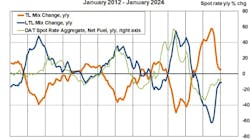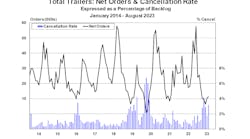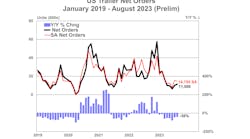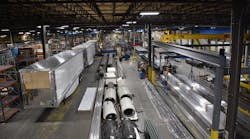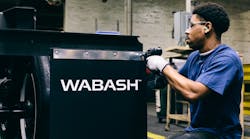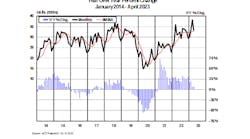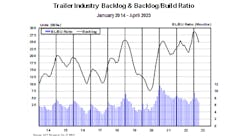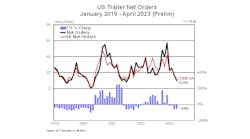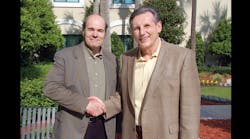THERE is some pent-up demand for van trailers, but it remains to be seen whether it is “across the board,” according to Steve Zaborowski, senior VP of XTRA Lease.
“There's a lot of chatter from people: ‘Our business is improving,’ ” he said. “We'll see during this year's freight season how strong the demand is and what sectors are recovering and whether they will translate into a big increase in demand for trucking services, which will certainly drive our business and certainly drive trailer manufacturers.
“There's improvement in the reefer market. The flatbed market remains difficult. We haven't bought any flatbeds in a couple of years. I expect slow growth in new-trailer demand. I'm not saying that's necessarily a bad thing. This industry is a very cyclical industry. We like it when there's slow, steady growth. It helps build the infrastructure. What we don't need is a big jump in demand in trailers — and nobody can provide component parts on time.”
His views on the current transportation market:
- Industry factors
“We believe there's a significant overcapacity of trucks and trailers. Our customers are having difficulty in obtaining credit for purchases. There are some qualifying companies, but financing is too expensive or they want to use capital for something else. We're hoping we can generate additional trailer builds by offering lease programs.”
- Freight densification
“They are reducing the volume of packaging, making it more efficient. And there will probably be requirements for fewer trailers to haul freight. So when you couple that with questions of running more efficient supply chains and stripping out more costs, it can become a challenging environment for trucks and trailers.”
- Conversion of truck to intermodal traffic
“You look at big public truckload companies, and they're not what they used to be. They either have a big double-stack train service that hauls containers that have replaced long-haul drivers and have become regional truckload, or they have dedicated contract carriers. That means they're hauling freight, on average, 500-700 miles. Over 100 miles, double-stack train is the primary service. You can't implement double-stack train service in every case because the service isn't quite there. But the railroads continue to have as a goal the converting of truck traffic to railroad. Intermodal, many expect, will continue to be a growth mode. Frankly, our industry has always capitalized. If railroads get filled up, trucking becomes a more important source of delivering freight.”
- Falloff in import ocean cargo
“Because of a lack of consumer spending, there is a lot less in-port cargo. When you have a constant downturn of 10%, 12%, 15% over a three-year period, it takes a long time for that cargo to build up. So we're hoping we see an improvement in consumer spending and import cargo because it does translate into more trailers and more trucking.”
- Increased efficiencies in supply chain
“There have been a lot of technical improvements. It used to be a focus on just the driver. There's lot of focus now on what's going on with freight. Our goal is to try to participate where supply-chain efficiencies exist. You have to get onboard and understand how that affects your business and what it means as far as planning and services.”
- Bypass of distribution centers
“Freight companies used to get some business, possibly. Import cargo comes in a container, and it's set up for the store delivery. Particularly on the West Coast, they don't take it to the distribution center, unload it, load it to trailers and deliver. Lots of times it's directly delivered to the store, and they get the container back for more freight.”
He sees these equipment challenges for the trailer industry:
-
Durability. “There's an extension of trailer life. Trailers used to be operated much shorter. The recession has taught people how to live with their assets longer, including us. So you guys have to figure out how to make a trailer that's durable for a minimum of 10 years in over-the-road service and can be used for local haulage for a few years after that, and still be a viable mobile-storage entity.”
-
Need for increased floor ratings. “We changed our own specs to go with 24,000-pound rated floors. It's unpredictable for us, if they're hauling potato chips or paper products. We decided to add some durability in floor systems. That's an important thing for our industry to think about.”
-
Lengthen the life of components (ie, doors) so they last longer and don't corrode.
-
Extended maintenance intervals. “We learned the hard way that there is no such thing as “maintenance-free.” You'll pay later. But if you do proper inspections, you can have fewer interruptions in service.”
-
Pressure to reduce tare weight of trailers. “For maximization of payloads, the first place they look is the trailer: ‘Where can we save weight?’ There will continue to be this pressure to make it more durable and at the same time take weight out.”
-
Effect of corrosion on trailers. “The component life of air and electrical systems has been costly for us. There are a lot of troubleshooting issues, rust-jacking on brake linings, coating systems, and general trailer cosmetic appearance.”
-
Equipment regulations' impact on trailer design. “As far as the ability to inspect and maintain key systems, I'm not sure how our operations folks are going to able to crawl under a trailer and measure brake-lining depth any more. This group should think about what it can do to make it easier.”
-
Design consequences (ie, slide ranges/side skirts). “You don't think about how you have additional slide ratings to comply with state regulations for load distribution, and then you realize the bogey is going to slide into the skirt. So coming up with designs to solve these kinds of problems is what we hope from this industry group.”
He said this is what is expected from trailer and component suppliers:
-
On time delivery. “We can't disappoint our customers.”
-
Engineering support. “We don't have an engineering group. We spend on component and trailer manufacturers to provide services and understand our customers' challenges and come up with solutions for these.”
-
Solutions for operating issues.
-
Testing of new design ideas to meet industry challenges.
-
Warranty support.
-
Fast action to solve technical issues.
-
Reduced administrative burden. “Companies that say, ‘You have to return this part and send this here.’ We're against that. We think it's a waste of time and efficiencies for both companies.”
-
Repair standards. “Consistent, clear instructions.”
-
Accuracy and consistency of model year. “If we were going to trade in a trailer and had two companies lined up, I'm not sure how an equipment manufacturer that was going to take a trade-in would know when a trailer was really built. Although it doesn't matter when they get a certain age, it does matter quite a bit on a resale and evaluation basis. So we would appreciate if the industry would try to figure out the best way to approach this that's reflective of identifying a clear way.”
Beal said FedEx has 14,000 power units and 42,000 trailers, and “I can tell you we absolutely have some pent-up demand.”
He said FedEx used 152 million gallons of diesel fuel in 2009, and expects to use 285 million this year.
“The LTL market has been in recession since 2006,” he said. “Fortunately for my company, we were able to continue to grow market share. But we were taking it off other people's trucks. It wasn't organic growth. So we've been seeing that downturn for four years. 3,065 trucking companies went out of business in 2008. It's been the weakest LTL environment in decades: shipment volume down, yield per shipment down, industry overcapacity driving pricing down.”
He said growth in LTL employment “will be slow and uneven. We look at the global economy. We're all over the world. But I'll tell you, there are some good signs. There's a backload of business in China. At the same time, we're very cautious. We see the economy as getting stronger. But when a new colt is born, when it gets to feet, it's wobbly. We believe that's the situation with the economy. It's getting to its feet, but is still wobbly and fragile.”
He said that many of their customers demand that the company identify its environmental policy and how it will produce a sustainable effort.
“In some cases, it's a deal breaker if you don't have something going,” he said. “Fortunately, we've been on that path for some time.”
He said FedEx is a charter partner in the Environmental Protection Agency's SmartWay Program and has a dedicated R&D team that is always working on new ways to improve fuel efficiency, safety, emissions reduction, and fuel quality and type.
“Our procurement approach includes no pre-buy to avoid new technologies (2002, 2007, 2010). From a power-unit standpoint since 2002, the cost of vehicles to us has gone over $20,000 just for emissions. So it's obviously a very expensive proposition.”
He said in terms of trailer preferences, FedEx presents “a very interesting dilemma” to trailer manufacturers.
“We want load efficiency,” he said. “We want to get all we can on that trailer. We don't get the weight on a trailer that our truckload brethren do as often as we might like to. We want the trailer as big as it can be with as much interior space as it can have. And by the way, it has to be strong.
“And we demand that it be beautiful. We do an inspection and walk around that vehicle and have a person taking measurements and taking pictures and everything is, ‘How does that trailer look?’ If it doesn't look right, it doesn't go on the road. Our brand is rated in the top 10 in the world as far as being recognizable. All these things are challenges that are dumped in your lap.”
He said most manufacturers claim that aerodynamic changes are providing fuel-economy improvements of 3.5% to 5%. He said FedEx is currently evaluating 12 skirts from three manufacturers.
“We're calculating the total cost of ownership from durability to susceptibility to damage,” he said. “We have a very tough environment. Our equipment has to be very, very well-designed. We're experimenting with that. If it proves to be the right direction to go, we'll put these on ourselves. But there may be other carriers who can't do that.”
